Tombs surrounded by low stone walls and guarded by naïve-looking stone statues are symbols of the natural environment and indigenous faiths of Jeju Island. The modest s on gentle mountain slopes provide insight into the history and philosophy of life and death among Jeju islanders, who have lived in harmony with nature.
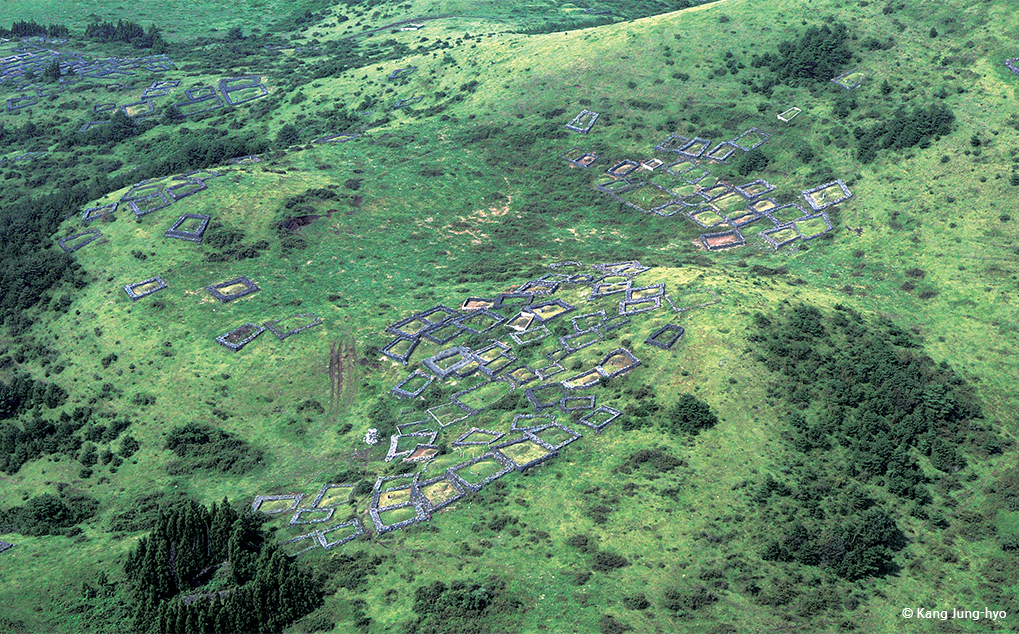
A parasitic cone named Dang Oreum, located in Gujwa-eup, is dotted with walled grave sites characterizing the landscape of Jeju Island. Stone walls surrounding tombs, called sandam, protect the tombs from fire and damage by grazing animals.
Around the world, people eventually adapt to their environment and make use of what it has to offer. To block wind from the sea, a natural condition of Jeju, the islanders constructed walls with rocks that had fallen away from sea cliffs or terraces chiseled out by waves, another natural feature of their island. The walls were built along the coast and the levees on fields and around tombs. Small guardian images also were carved from the stones and assigned to tombs.
The iconic stone walls of Jeju represent the accumulated labor of several generations. Fathers would take large rocks and hack them into manageable shapes and sizes. Sons would then use the stones to build walls. Afterwards, when mothers tilled the fields, they would plug holes in the walls with the small stones their hoes would invariably scrape up. It is unknown for how long this simple but arduous process was repeated but an aerial scanning of Jeju immediately reveals black stone walls of all sizes covering the entire island. It seems to form one colossal work of art. This enigmatic monument, built by unknown artists who seemingly used the land as their canvas, stands out for its natural beauty rather than as a work of human hands.
The stone walls of Jeju are all the same in that they crisscross the land without being bound by any rules or styles, twisting and turning as they please. The undulating ribbons of basalt appear as natural as if they had been blown into place. This probably is why someone said, “The stone walls of Jeju were one with the land from the very beginning.”
Without the abundance of basalt, the islanders would not have been able to properly build homes for themselves, shelters for their livestock, or tombs for the souls of the dead.
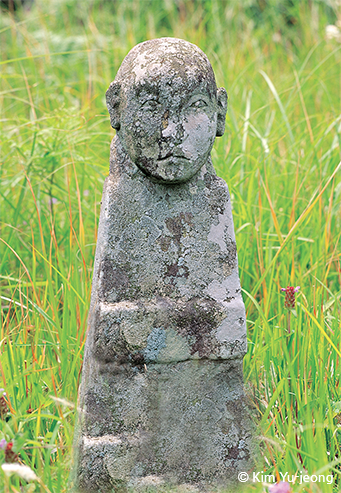
Stone statues in the shape of young children, called dongjaseok, stand guard over tombs. The simple statues are characterized by the rough texture of porous basalt and a mysterious aura.
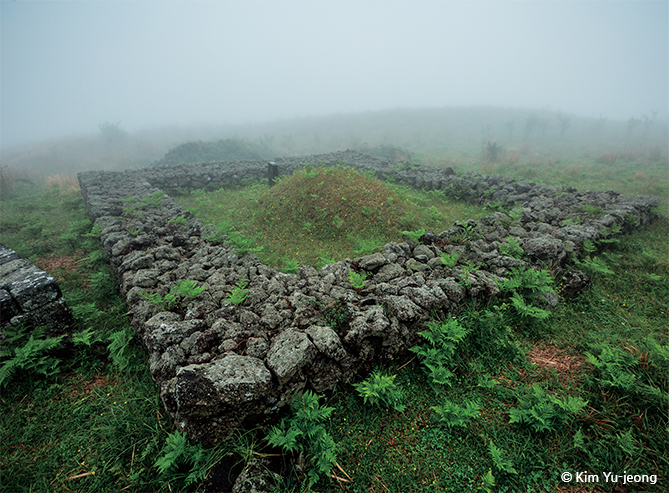
The walls surrounding a tomb have one or multiple rows of stone. The size and shape of the walls are indicative of a family’s status.
Walls for the Dead
The volcanic rocks that carpet the island - are they a nuisance or a cosmic gift? When they disrupt a farmer in his field, they are, at that moment, an unwelcome annoyance. But without the abundance of basalt, the islanders would not have been able to properly build homes for themselves, shelters for their livestock, or tombs for the souls of the dead. The ebony and gray volcanic rocks of Jeju are inextricably linked to life and death. From cradle to grave, walls of stone are fixtures of the islanders’ lives. Their homes are enclosed by them, as are their final resting sites.
The stone walls surrounding tombs are called sandam (san means “mountain” and dam means “wall”). They protect burial sites and designate their boundaries. The sacred walls are either built in a single or multiple rows. The single-row sandam have a circular, acorn or square shape. Some of the multiple-row sandam form a trapezoid configuration with the narrow side at the back of the tomb.
Each sandam has a gate to provide a passageway for the spirit of the deceased. Called olle, the gate is only 40 to 50 centimeters wide. It is typically on one of the sides and which one depends on the gender of the interred: left for males and right for females. When a couple is buried together, the gate is on the left side, but in some special cases, there is a gate on both sides. Occasionally, burial sites also feature a front gate. On either side of the opening, several long stones are placed on top of the wall to control the entry of animals or people.
Initially, tombs were placed in the middle of a field, hence the need for a wall to protect them from damage by livestock as well as stormy weather. As crop farming claimed more and more land, tombs were increasingly placed on the edge of fields. It may also be that the change in location was made for the convenience of family and relatives taking care of the tombs. Regardless of the location of a tomb, the stones of the enclosing walls were sacred and touching them was strictly forbidden. Without permission or a valid reason no one was allowed inside the walls. There were exceptions, however. It was believed that when a traveler from far away who had lost his way spent the night inside the walls, he would be protected by the spirit of the dead.
Unlike most stone walls of Jeju, sandam have a beauty and grace that reflect the technical expertise of their builders. Their special artistry is found in the shapes of the lines that the walls form, which are reminiscent of the lines of other Korean structures. For example, the eaves on a traditional Korean tile-roof house draw a curve that softens toward the ends, which point upward and impart a sense of rhythm and flight. The lines of the sandam share the same beautiful contour. Starting low at the back, the wall curves slowly upwards as it moves towards the front, then at the left corner the wall rises, as if it is reaching for the sky. It gradually sinks lower toward the middle as it moves to the right, then rises again tosymmetry with the left side. Here the wall stops. The line ends, imparting a tranquil mood.
Errand Boys of the Souls
Stone statues were installed behind the stone enclosures surrounding tombs. They are called dongjaseok, meaning “stone statue of a young child.” They serve the souls of the dead in various ways, as attendants for worship and ritual offerings, acting as sentries, and providing decoration. These images were introduced by sojourners from the mainland such as magistrates appointed by the central government, exiles, and powerful members of the local landed gentry who served in the central government. But the islanders did not simply replicate the statues from the mainland, which initially had a Buddhist influence.
Similar stone guardians first appeared at tombs on the outskirts of Hanyang (Seoul), the capital and center of Confucian culture in Korea. As they were introduced to regions all the way down to Jeju, the southernmost part of the country, the statues came to reflect the different customs and faiths of the regions. Additional influence from the culture and philosophy of Jeju resulted in statues unique to the island. Thus, they project elements of Taoism, Buddhism, shamanism and various indigenous faiths.
The Jeju dongjaseok have a familiar warmth to them. Those made during the reigns of King Yeongjo (r. 1724-1776) and King Jeongjo (r. 1776-1800) exhibit the finest craftsmanship, featuring bulging eyes and soft lines. They are the result of work experience on the mainland. Whenever a state funeral was to be held, the people of Jeju were quick to volunteer their services. In 1629, during the reign of King Injo, a ban on entering the mainland was decreed, rendering it difficult for Jeju islanders to travel. Volunteering to work for the state was an effective way to circumvent the ban.
After returning home to Jeju, the volunteers red stone figures based on what they had seen while constructing royal tombs. They are the dongjaseok of Jeju one can still see today. They were modeled on the guardian figures of civil officials at royal tombs, but in the hands of amateur craftsmen who lacked technical skills, they took on an entirely different appearance. Made of basalt, rarely seen on the mainland, the Jeju stone figures are indeed unique. Characterized by the healthy primitiveness that emanates from their simplistic beauty, they are widely loved as the face of Jeju.
Stones as Tools for Everyday Life
The abundance of basalt on Jeju naturally led to the widespread use of stone implements. Besides, relying on wooden tools was risky as they were susceptible to rotting due to the high precipitation and humidity on the island. The most popular stone implements on Jeju were water jar stands (mulpang), millstones (dolbangae) and pig pens (dottongsi). Other common stone implements included grinding stones (maetdol), braziers (hwaro), stone posts for door latches (jeongjuseok), and bowls (dogori). Although the islanders no longer use these traditional stone devices, they evoke plenty of nostalgia.
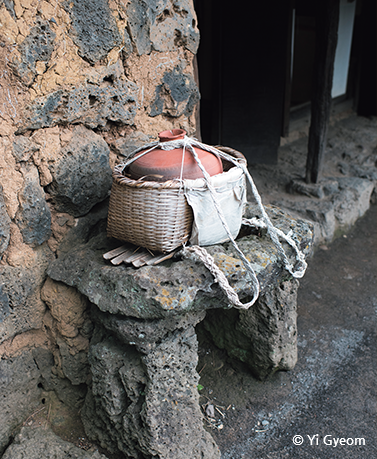
A stone slab served as a stand for the pottery jar that women of Jeju used to carry water. It was generally placed right outside the kitchen door.
Mulpang (Water Jar Stand)
The mulpang is a square slab of basalt on which the Jeju earthenware water jar, called heobeok, was placed. Considering its function and women’s daily movement around the house, it was generally installed just outside the kitchen door. In premodern times, Jeju women had to collect water from communal springs several times a day, carrying the water jar on their backs. When they returned home, they would lower the jar onto the stone slab.
The distance between water sources and households varied, but in general it was far. Along the coast, spring water was usually found flowing about one kilometer away from most villages. Called sanmul, this spring water varied in quantity with the ebb and flow of the tide, and the villagers drew their water accordingly. In mountain villages, residents drank water drawn from reservoirs of rainwater called bongcheonsu, and collected rainwater running down tree trunks for washing and other household purposes. In some places that lacked spring water, rainwater running down the thatched roofs of the houses was collected and stored for drinking.
Collecting water for their families and livestock was generally the job of women and young girls. For Jeju females, carrying the heobeok to and fro became part of their daily lives at a young age. In fact, they generally started each day by collecting water in their jars. The usually blackish-red jar was round to make it easier to carry and had a full round belly and narrow neck, which helped minimize spilling when carried over a long distance. These jars were made in different sizes to suit the age of the person carrying them.
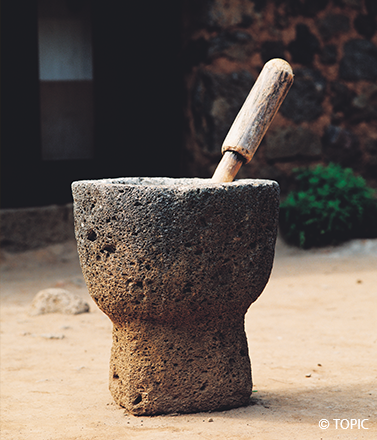
Millstones were used to grind grains into powder to make rice cakes for ancestral rites. They were also useful for making a natural dye for cloth by crushing green persimmons into pulp.
Dolbangae (Millstone)
Jeju islanders considered the death anniversaries of their ancestors more important than the birthdays of living family members. Hence, every home needed a mill to grind grains into powder, which was then used to make rice cakes for ancestral memorial rites. The household millstones were operated by two or three women taking turns.
The millstones were also useful for making work clothes. After summer rains, most Jeju households picked persimmons and used their juice to dye cloth. Green persimmons crushed in a millstone produce seeds that are shaped like a half moon (seeds with a dry, aent taste that children eat for fun). Cotton or ramie cloth is placed in the millstone and covered with the persimmon pulp to dye in the juice and then hung on a stone wall to dry in the sun. When the cloth dries, it is repeatedly soaked in water and dried again for more than 10 days until it becomes stiff and tough. This persimmon-dyed cloth is called galcheon and the clothes made with it garot. All sorts of work clothes were made with this cloth. They were cool and antiperspirant, and became stronger and deeper in color the more they were washed.
To crush grains, however, a wooden mortar called nambangae was often preferred to the millstone because it was lighter and easier to maintain. When not in use, the millstone was propped against an outside corner, while the wooden mortar was stored in the barn to keep it out of the rain.
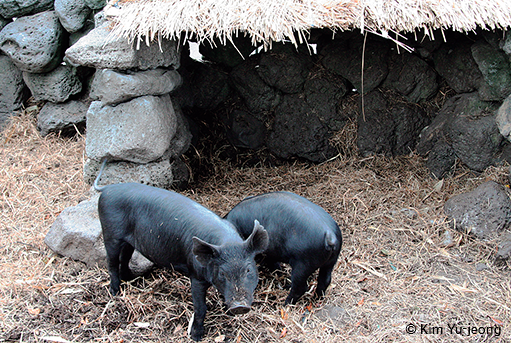
Stone pig pens also served as an outhouse. The manure was used to fertilize fields.
Dottongsi (Pig Pen)
Jeju’s traditional pig pens built of stones are called dottongsi or dottong. Pigs were a very important household animal as a source of protein. But as grain feed was scarce, the pigs were mainly raised on human waste.
The stone pig pen also functioned as an outhouse and a place to produce manure needed to fertilize crops. Barley straw was laid on the ground and when the pigs, fed on human waste, produced their own waste and crushed it underfoot, the droppings and straw mixed together toa kind of fertilizer. In winter, the straw mixture was placed outside to ferment over two to three months; in the spring, it was mixed with barley seeds and spread on the fields.
There was another reason for rasing pigs inside the yard. On Jeju Island, when a son or daughter reached marrying age, families bought a couple of young pigs to raise. After about a year, the pigs were big enough to be butchered for the wedding dinner.
The dish typically served to guests at a Jeju wedding was called gogitban, or literally “meat slices.” It consisted of three thin slices of pork, one piece of stuffed pork chitterlings and one or two pieces of bean curd. To this day, when the islanders inquire about a person’s marriage plans, they often ask, “When are you going to serve us three pieces of meat?”
Although pigs raised on human waste, colloquially called “dung pigs” (ttong doeji), disappeared long ago, Jeju’s black pigs, designated as Natural Monument No. 550 in 2015, are a local icon and a source of pride for the islanders.
Kim Yu-jeongDirector, Institute of Jeju Culture